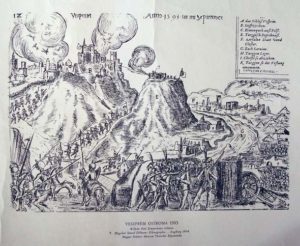Eörsy Péter (? – 1602)

Eörsy Péter was born in Komárom County and was a soldier from his youth. He was promoted from a simple hussar to the rank of captain and had the necessary qualities: courage, humanity, and military expertise.

In the 1580s he served as a hussar captain in Pápa. He regularly took part in the Danube campaigns in the Borderland. Not only his bravery but also his chivalry was known to his opponents and the Turks respected him. They kept sending him letters in later years. The Viennese court also corresponded with him frequently, as he knew how many Hungarians were imprisoned in each Turkish-held castle, often by name.

Later he served in Érsekújvár (Nové Zámky), and then in Veszprém. In Veszprém he was in charge of the castle guard when Grand Vizier Sinan Pasha decided to besiege Veszprém in the autumn of 1593, the first year of the Fifteen Years’ War. He arrived on 3 October and within a few days, he had almost demolished the walls of the poorly fortified fortress. A fire broke out and the garrison fought off several attacks in vain, seeing no point in resisting. Finally, they decided to break out in the direction of Pápa.

Then, on the night of 6-7 October, they sneaked out of the castle, but the Turks spotted the defenders on the move. In the attack, almost the entire guard was cut down or captured. The captains Ferrando Zamaria de Spezie Casa and Georg Andreas Hoffkirchen were also captured. Barely 40 German and 48 Hungarian soldiers out of 1,000 made it to Pápa. Among them was Eörsy.

He then served as a cavalry captain in Győr, but this castle also fell to the Turks in September 1594. Eörsy went to Óvár, where he was arrested the following year by the captain of the castle, Siegmund Hager, and tried for treason for the loss of Veszprém. He was sentenced to death but was pardoned.

He returned to military service and in 1595 he became the vice-captain of Esztergom, but since the chief captain, Pálffy Miklós, was often absent, he essentially ran the affairs of the castle. The castle was in a vulnerable position, close to Buda, and the Turks repeatedly tried to retake it by force or trickery, but Eörsy was aware of this. In one of his letters, he reacted to the Turks’ trickery in the following way: “The cold of the fox is not upon us so that we do not smell the stench of your deceit!” (In Hungarian:
“a róka náthája nincsen rajtunk, hogy meg ne éreznénk csalárdságtok bűzit!”)

The connection between the two officers may have been older, as on 2 May 1597 he informed Pálffy that the Turks were taking grain to Tata castle on ships. The boatmen of Eörsy then attacked and captured the Turkish ships. Read more about Pálffy Miklós here:
Eörsy also took an active part in the heroic recapture of Győr in the early spring of 1598. He and 1,000 Hajdús forced their way through the gate, which had been blown open with explosives, and fought a bloody battle with the defenders. They tried to capture the brave Ali Pasha, but it was impossible, and the Pasha was mortally wounded with two rifle shots and dragged in front of Adolf of Schwarzenberg. Eörsy lost more than 300 of his soldiers in the battle. In his report, Pálffy praised the bravery of Eörsy and the Hajdú soldiers.

Not all the details of his activities during the war are known, but his regular reports on Turkish movements show that he did not rest. After the loss of Székesfehérvár castle in 1601, the Pasha of Buda scolded his chiefs: “You dogs! You have negotiated peace with Eörsy Péter for so long that you have betrayed Fehérvár!” In this way, he implied that Eörsy had played an important role in the negotiations between the parties.

In 1602 he was part of the army that marched to the siege of Buda, but before that, sometime at the end of the summer, he defeated the 1200-man army of the Pasha of Eger. Archduke Matthias himself reported the battle on 4 September, enclosing Eörsy’s letter with the confessions of the Turkish prisoners.

The commander of the campaign, Christoph Russwurm, appointed Eörsy to command the castle of Pest, which was taken on 6 October. However, when the relief army of Yemish Khasan Pasha arrived on the 13th, the besiegers were besieged. The defenders of Pest fought hard and even launched sallies, of which the 20th was successful. On 26 October, however, for unknown reasons, panic broke out among the defenders. Eörsy tried to stop the fleeing men with his sword drawn, but he cut down some of them in vain and was trampled underfoot, his body barely recognizable.

We know little about his family, he did not dare to take his wife to Esztergom but settled her near Eger. We do not know what happened to her when Eger was occupied. In Győr, there is a street named after him and a memorial plaque commemorating Eörsy Péter.

Source: Szibler Gábor
Dear Readers, I can only make this content available through small donations or by selling my books or T-shirts.
If you like my writings, please feel free to support me with a coffee here:
You can check out my books on Amazon or Draft2Digital, they are available in hardcover, paperback, or ebook:
https://www.amazon.com/dp/198020490X
or at https://books2read.com/b/boYd81


My work can also be followed and supported on Patreon: http://Become a Patron!

My work can also be followed and supported on Patreon: Become a Patron!

https://hungarianottomanwars.myspreadshop.com/all



